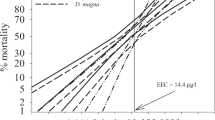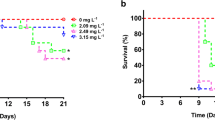Abstract
Daphnia magna were exposed under semistatic conditions (i.e., conditions taking natural degradation into account) to a pesticide mixture consisting of a pyrethroid insecticide (cyfluthrin) and a pre-emergent herbicide (diuron) as well as pesticides individually using a full life cycle exposure (21 days). Subsequently, offspring from the second reproductive brood were used to continue exposure for a second generation. Survival, time to first brood, total number of offspring produced, number of broods produced, growth rate, and population growth rate were recorded for each generation and concentration. Significant differences existed between F0 and F1 D. magna for survival, in which F1 were less sensitive to pesticide mixtures than F0. In addition, F1 D. magna were significantly smaller than F0, which resulted in longer time to first brood. There were no differences in any end point examined between D. magna exposed to the pesticide mixture and diuron alone, although differences existed in survival, total number of offspring, total number of broods, and population growth rate when F0 D. magna were exposed to cyfluthrin alone. This study illustrates the utility of a two-generation study design that may more fully reflect, and more accurately predict, population level effects of pesticide exposures to short-lived aquatic organisms.

Similar content being viewed by others
References
Baird DJ, Barber I, Calow P (1990) Clonal variation in general responses of Daphnia magna Straus to toxic stress. I. Chronic life-history effects. Funct Ecol 4:399–407
Baldwin WS, Milam DL, Leblanc GA (1995) Physiological and biochemical perturbations in Daphnia magna following exposure to the model environmental estrogen diethylstilbestrol. Environ Toxicol Chem 14:945–952
Bervoets L, Baillieul M, Blust R, DeBoeck G, Verheyen R (1993) Impact assessment of industrial effluents on freshwater ecosystems. Sci Total Environ 134 (Suppl 2):1123–1128
Brausch JM, Smith PN (2009) Development of resistance to cyfluthrin and naphthalene among Daphnia magna. Ecotoxicology 18:600–609
Brausch JM, Cox S, Smith PN (2006) Pesticide usage on the Southern High Plains and acute toxicity of four chemicals to the fairy shrimp Thamnocephalus platyurus. Tex J Sci 58:309–324
Cairns J Jr (1983) Are single species toxicity tests alone adequate for estimating environmental hazard? Hydrobiologia 100:4–57
Caswell H (2001) Matrix population models: construction, analysis, and interpretation, 2nd edn. Sinauer Associates, Sunderland
Coupe RH, Thurman EM, Zimmerman LR (1998) Relation of usage to the occurrence of cotton and rice in three streams of the Mississippi delta. Environ Sci Technol 32:3673–3680
DPR Pesticide Chemistry Database (2003) Environmental Monitoring Branch. Department of Pesticide Registration, Sacramento, CA
Day K, Kaushik NK (1987) An assessment of the chronic toxicity of synthetic pyrethroid, fenvalerate, to Daphnia galeata mendotae, using life tables. Environ Pollut 44:13–26
Eaton DL, Klaassen CD (2001) Principles of toxicology. In: Klaassen CD (ed) Casarett & Doull’s toxicology: the basic science of poisons. McGraw-Hill, New York, pp 11–34
Enserink L, Luttner W, Maas-Diepeveen H (1990) Reproductive strategy of Daphnia magna affects the sensitivity of its progeny in acute toxicity tests. Aquat Toxicol 17:15–26
Flickinger AL, Bruins RJF, Winner RW, Skillings JH (1982) Filtration and photoactive behavior as indices of chronic copper stress in Daphnia magna Straus. Arch Environ Contam Toxicol 11:457–463
Forbes VE, Calow P (1999) Is the per capita rate of increase a good measure of population-level effects in ecotoxicology? Environ Toxicol Chem 18:1544–1556
Hammers-Wirtz M, Ratte HT (2000) Offspring fitness in Daphnia: is the Daphnia reproduction test appropriate for extrapolating effects on the population level? Environ Toxicol Chem 19:1856–1866
Hanazato T (1998) Growth analysis of Daphnia early juvenile stages as an alternative method to test the chronic effects of chemicals. Chemosphere 36:1903–1909
Hoegland KD, Drenner RW, Smith JD, Cross DR (1993) Freshwater community response to mixtures of agricultural pesticides: effects of atrazine and bifenthrin. Environ Toxicol Chem 12:627–637
Howard PH (1991) Handbook of environmental fate and exposure data for organic chemicals. Lewis, Chelsea, pp 9–21
Isensee AR (1976) Variability of aquatic model ecosystem-derived data. Int J Environ Stud 10:35–41
Kersting K (1975) The use of microsystems for the evaluation of the effect of toxicants. Hydrobiol Bull 9:102–108
Kungolos A, Samaras P, Kipopoulou AM, Zoumboulis A, Sakellaropoulos GP (1999) Interactive toxic effects of agrochemicals on aquatic organisms. Wat Sci Tech 40:357–364
Lampert W, Trubetskova I (1996) Juvenile growth rate as a measure of fitness in Daphnia. Funct Ecol 10:631–635
Lichtenstein EP, Liang TT, Anderegg BN (1973) Synergism of insecticides by herbicides. Science 181:847–849
Munn MD, Gilliom RJ, Moran PW, Nowell LH (2006) Pesticide toxicity index for freshwater aquatic organisms, 2nd ed. United States Geological Survey Scientific Investigation Report 2006-5148, Reston, 87 pp
Munzinger A, Monicelli F (1992) Heavy metal co-tolerance in a chromium tolerant strain of Daphnia magna. Aquat Toxicol 23:203–216
Organisation for Economic Co-operation and Development (1984) Guidelines for testing chemicals. Daphnia sp. acute immobilization test and reproduction test. OECD, Paris
Rupp DE, Peachey RE, Warren KL, Selker JS (2006) Diuron in surface runoff and tile drainage from two grass-seed fields. J Environ Qual 35:303–311
Salice CJ, Miller TJ, Roesijadi G (2009) Demographic responses to multigeneration cadmium exposure in two strains of the freshwater gastropod, Biomphalaria glabrata. Arch Environ Contam Toxicol 56:785–795
Sanchez M, Ferrando MD, Sancho E, Andreu E (1999) Assessment of the toxicity of a pesticide with a two-generation reproduction test using Daphnia magna. Comp Biochem Physiol C 124:247–252
Stark JD, Tanigoshi L, Bonfour M, Antonelli A (1997) Reproductive potential: its influence on the susceptibility of a species to pesticides. Ecotoxicol Environ Safe 37:273–279
Thurman EM, Zimmerman L, Scribner E, Coupe R Jr (1998) Occurrence of cotton pesticides in surface water of the Mississippi embayment. USGS Fact Sheet FS-022-098. United States Geological Survey, Washington
Thurman EM, Bastian KC, Mollhagen T (2000) Occurrence of cotton herbicides and insecticides in playa lakes of the High Plains of West Texas. Sci Total Environ 248:189–200
Tsui MTK, Wang W-X (2004) Maternal transfer efficiency and transgenerational toxicity of methylmercury in Daphnia magna. Environ Toxicol Chem 23:1504–1511
United States Environmental Protection Agency (1986) Daphnia magna life-cycle (21-day renewal) chronic toxicity test. USEPA, Washington. EPA 540/9-86-141
United States Environmental Protection Agency (1992) Pesticide environmental fate one line summary: Cyfluthrin. USEPA, Washington
United States Environmental Protection Agency (1997) Pesticide fact sheet number 164: Cyfluthrin. USEPA Office of Pesticide Programs, Washington
United States Environmental Protection Agency (2002) Methods for measuring the acute toxicity of effluent and receiving waters to freshwater and marine organisms, 5th ed. EPA-821-R-02-012. USEPA, Washington
United States Environmental Protection Agency. ECOTOX database system. http://www.epa.gov/med/databases/databases.html#aquire. Accessed 1 April 2009
Van Leeuwen CJ, Luttmer WJ, Griffieon PS (1985) The use of cohorts and populations in chronic toxicity studies with Daphnia magna: a cadmium example. Ecotoxicol Environ Safe 9:26–39
Villarroel MJ, Ferrando MD, Sancho E, Andreu E (2000) Effects of tetradifon on Daphnia magna during chronic exposure and alterations in the toxicity to generations pre-exposed to the pesticide. Aquat Toxicol 49:39–47
Ward TJ, Robinson WE (2005) Evolution of cadmium resistance in Daphnia magna. Environ Toxicol Chem 24:2341–2349
Author information
Authors and Affiliations
Corresponding author
Rights and permissions
About this article
Cite this article
Brausch, J.M., Salice, C.J. Effects of an Environmentally Realistic Pesticide Mixture on Daphnia magna Exposed for Two Generations. Arch Environ Contam Toxicol 61, 272–279 (2011). https://doi.org/10.1007/s00244-010-9617-z
Received:
Accepted:
Published:
Issue Date:
DOI: https://doi.org/10.1007/s00244-010-9617-z




